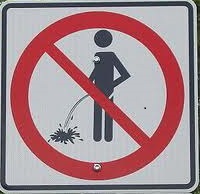Archive
Can I get HIV from urine?
***
Today’s Question:
“Can I get an HIV infection from urine? This past weekend, my roommate was drunk and he urinated all over my backpack. I picked up the backpack and emptied out the contents and then held it under the faucet in the bathtub to rinse it out. Should I make him get an HIV test? What’s my risk of getting HIV?”
…PISSED at my roommate
***
From Centers for Disease Control (link):
How is HIV passed from one person to another? expanded
Only certain fluids—blood, semen (cum), pre-seminal fluid (pre-cum), rectal fluids, vaginal fluids, and breast milk—from an HIV-infected person can transmit HIV. These fluids must come in contact with a mucous membrane or damaged tissue or be directly injected into the bloodstream (from a needle or syringe) for transmission to possibly occur. Mucous membranes can be found inside the rectum, the vagina, the opening of the penis, and the mouth.
In the United States, HIV is spread mainly by
- Having unprotected sex (sex without a condom) with someone who has HIV.Sharing needles, syringes, rinse water, or other equipment (works) used to prepare injection drugs with someone who has HIV.
- Anal sex is the highest-risk sexual behavior. Receptive anal sex (bottoming) is riskier than insertive anal sex (topping).
- Vaginal sex is the second highest-risk sexual behavior.
- Having multiple sex partners or having other sexually transmitted infections can increase the risk of infection through sex.
Less commonly, HIV may be spread by
- Being born to an infected mother. HIV can be passed from mother to child during pregnancy, birth, or breastfeeding.
- Being stuck with an HIV-contaminated needle or other sharp object. This is a risk mainly for health care workers.
- Receiving blood transfusions, blood products, or organ/tissue transplants that are contaminated with HIV. This risk is extremely small because of rigorous testing of the US blood supply and donated organs and tissues.
- Eating food that has been pre-chewed by an HIV-infected person. The contamination occurs when infected blood from a caregiver’s mouth mixes with food while chewing, and is very rare.
- Being bitten by a person with HIV. Each of the very small number of documented cases has involved severe trauma with extensive tissue damage and the presence of blood. There is no risk of transmission if the skin is not broken.
- Oral sex—using the mouth to stimulate the penis, vagina, or anus (fellatio, cunnilingus, and rimming). Giving fellatio (mouth to penis oral sex) and having the person ejaculate (cum) in your mouth is riskier than other types of oral sex.
- Contact between broken skin, wounds, or mucous membranes and HIV-infected blood or blood-contaminated body fluids. These reports have also been extremely rare.
- Deep, open-mouth kissing if the person with HIV has sores or bleeding gums and blood is exchanged. HIV is not spread through saliva. Transmission through kissing alone is extremely rare.
***
So, you should be OK. While a urine-soaked backpack does not sound like a lot of fun, you don’t need to worry about contracting an HIV infection from touching the backpack while you were rinsing it out. No need to ask your roommate to get an HIV test for that reason alone. Maybe some other roommate discussions about appropriate behavior and excessive alcohol use might be in order?
Get Yourself Tested: GYT 2014!!
April is GYT month
###
Check out this video:
Thanks to “Bedsider.org” for the above video.
###
For the entire month of April, U. of Iowa Student Health and Wellness is offering free testing for
Chlamydia and Gonorrhea to all UI students.
###
HIV testing is also available for a low $25 charge.
Testing is confidential.
###
Call 335-8394 to schedule an appointment for STI testing.
###
###
Think you know a lot about STIs? Try taking the “GYT Quiz” here:
###
Click here to take the quiz
###
###
***
Other GYT LINKS:
STD Awareness Resource Site
###
MTV; It’s Your Sex Life. GYT homepage
###
Links We Like #4
An Oldie but Goodie: HPV, Warts and Gardisil Vaccine
This was originally posted one year ago, on 02/14/13, but still good stuff:
Consider the information presented and think about getting the Gardisil, HPV vaccine 3-shot series.
Be sure to check out the video link below; “Health Sesh with Keith and Beth”.
*** *** *** *** ***
HAPPY VALENTINES DAY!!
…
Today’s Question:
…
My best friend in my sorority just got the HPV/wart vaccine and told me I should be getting it too. I don’t want to get warts, but I’m not sure about this vaccine. What can you tell me about it? Should my boyfriend get the vaccine and should he be tested for HPV infection?
***
Dr. Laros: HPV or Human Papilloma Virus is actually a group of over 100 viruses that infect the skin. Certain types or strains of this virus cause warts on the hands or feet and others cause warts on the genitals. Those strains of HPV that affect/infect the genitals are sexually transmitted illnesses.
Dr. Evans: Some strains of the HPV virus that infect the genitals will cause visible warts but other strains that do not cause warts will cause changes in normal cells which can lead to cancer, specifically cancer of the cervix in women and some forms of anal or oral cancer that can occur in men and women.
Dr. Laros: Of the >100 strains of HPV, two strains, HPV-16 and HPV-18 cause 70% of cervical cancers and two other strains, HPV-6 and HPV-11 cause 90% of all genital warts. The Gardasil ® vaccine for HPV contains these 4 strains of HPV (6,11,16 and 18) and is given as 3 shots into the arm over a 6 month period.
Dr. Evans: The HPV vaccine is approved for use in both females and males from 11 through 26 years of age. Most health insurance plans will cover all or most of the cost of this vaccine, but individuals should always check with their own insurance about coverage and out of pocket costs.
Dr. Laros: This vaccine is available for male and female students at Student Health. You can schedule an appointment to get the vaccine by calling 335-8394.
Dr. Evans: Whether or not to get the HPV vaccine is a decision you should make after getting the facts and discussing it with your healthcare provider. The HPV vaccine is thought to be most effective when given early, before you have intercourse for the first time, but is effective if given later.
Dr. Laros: Genital HPV infection is extremely common. Estimates are that 80% or more of people who have been sexually active will have an HPV infection at some time in their life. Many are unaware that they ever had an HPV infection and most cases, those infected will clear the infection/fight it off with their own immune system.
Dr. Evans: Because this vaccine is now approved for use in men, I would especially hope that male UI students would seriously consider getting this vaccination to protect themselves and their current (and future) sexual partners from HPV infection and cancer. In my opninion, it would be great if your boyfriend got this vaccination! What a nice Valentine’s Day gift, huh?
Laros: Certain strains of the HPV virus can lead to changes that can cause cervical cancer over time. For this reason, women should have a screening test called a PAP smear starting at age 21 and then regularly every 2-3 years during her 20s and every 3-5 years after age 30. There is no screening test for HPV infection in men.
Today’s Statistics:
…
HPV vaccination has also been found to prevent nearly 100 percent of the precancerous cervical cell changes that would have been caused by HPV 16/18.
Source: National Cancer Institute
Over 70% of new genital HPV infections occur in 15-24 year olds.
…
Today’s Info Links:
.
Navigating HPV interactive tool:
…
American Social Health Association on HPV
…
CDC Cervical Cancer Screening info site:
http://www.cdc.gov/cancer/cervical/basic_info/screening.htm
PAP Smear results; information from CDC:
http://www.cdc.gov/std/hpv/pap/#sec2
Got a sex question?
Leave us a comment or submit your question(s) to:
Chlamydia Infections in UI Students, 2013
Today’s trivia question:
***
Of all University of Iowa students tested for Chlamydia in the calendar year 2013, how many tested POSITIVE?
***
(That is, what percentage of UI students that were tested for Chlamydia had positive tests, indicating a sexually acquired Chlamydia infection?)
Take your best guess in the reader poll below, then scroll down below graphic of man thinking for answer.
***
***
***
***
***
Answer: C) 6.9% or about 1 in every 14 students tested.





